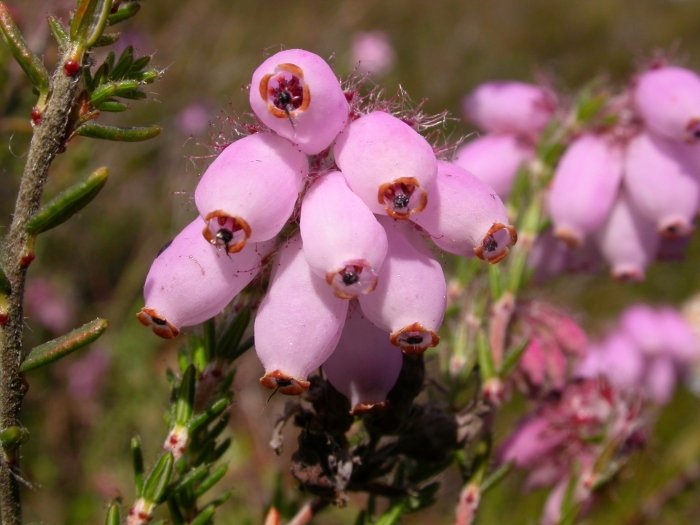Cross-Leaved Heath
(Erica tetralix)
Cross-Leaved Heath (Erica tetralix)
/
/

Sigitas Juzėnas
CC BY 4.0
Image By:
Sigitas Juzėnas
Recorded By:
Copyright:
CC BY 4.0
Copyright Notice:
Photo by: Sigitas Juzėnas | License Type: CC BY 4.0 | License URL: http://creativecommons.org/licenses/by/4.0/ | Rights Holder: Sigitas Juzėnas | Publisher: iNaturalist | Date Created: 2007-07-19T13:05:41-07:00 |






















Estimated Native Range
Summary
Erica tetralix, commonly known as Cross-leaved Heath, is a perennial subshrub native to peat bogs, wet heaths, and damp coniferous woodlands across western Europe, from southern Portugal to central Norway, and in boggy regions of Central Europe, including Austria and Switzerland. This member of the Ericaceae family typically grows to a height of 10-50 cm and spreads 10-50 cm wide. The plant is characterized by its evergreen nature and distinctive whorls of four narrow, glandular leaves. From June to September, Cross-leaved Heath produces small, pink, bell-shaped flowers that droop in clusters at the ends of shoots, creating a delicate and showy display.
Cross-leaved Heath is valued for its hardiness and the year-round interest it provides in gardens, with its summer to autumn blooming period and its ability to thrive in acidic, nutrient-poor soils. It is often used in rock gardens, heath gardens, and as ground cover. In cultivation, it requires full sun to part shade, consistent moisture, and well-drained, acidic soil. While it is generally low-maintenance, it can be susceptible to root rot if overwatered or planted in poorly drained soils. Cultivars like ’Alba Mollis’ and ’Pink Star’ have been recognized for their garden merit, offering variations in flower color and form. Darwin’s hypothesis of protocarnivory adds an interesting aspect to its ecology, though it is not a confirmed trait.CC BY-SA 4.0
Cross-leaved Heath is valued for its hardiness and the year-round interest it provides in gardens, with its summer to autumn blooming period and its ability to thrive in acidic, nutrient-poor soils. It is often used in rock gardens, heath gardens, and as ground cover. In cultivation, it requires full sun to part shade, consistent moisture, and well-drained, acidic soil. While it is generally low-maintenance, it can be susceptible to root rot if overwatered or planted in poorly drained soils. Cultivars like ’Alba Mollis’ and ’Pink Star’ have been recognized for their garden merit, offering variations in flower color and form. Darwin’s hypothesis of protocarnivory adds an interesting aspect to its ecology, though it is not a confirmed trait.CC BY-SA 4.0
Plant Description
- Plant Type: Shrub
- Height: 1-1.5 feet
- Width: 1-1.5 feet
- Growth Rate: Slow, Moderate
- Flower Color: Pink
- Flowering Season: Summer, Fall
- Leaf Retention: Evergreen
Growth Requirements
- Sun: Full Sun
- Water: Medium
- Drainage: Medium, Slow
Common Uses
Bee Garden, Bird Garden, Deer Resistant, Groundcover, Hummingbird Garden, Low Maintenance, Showy Flowers, Water Garden
Natural Habitat
Peat bogs, wet heaths, and damp coniferous woodlands
Other Names
Common Names: Cross-leaved Heath, Irish Heath, Bog-Heather
Scientific Names: , Erica tetralix, Eremocallis glomerata, Erica botuliformis, Erica glomerata, Erica martinesii, Erica martinesii, Erica rubella, Erica tetralix f. alba, Erica tetralix f. mollis
GBIF Accepted Name: